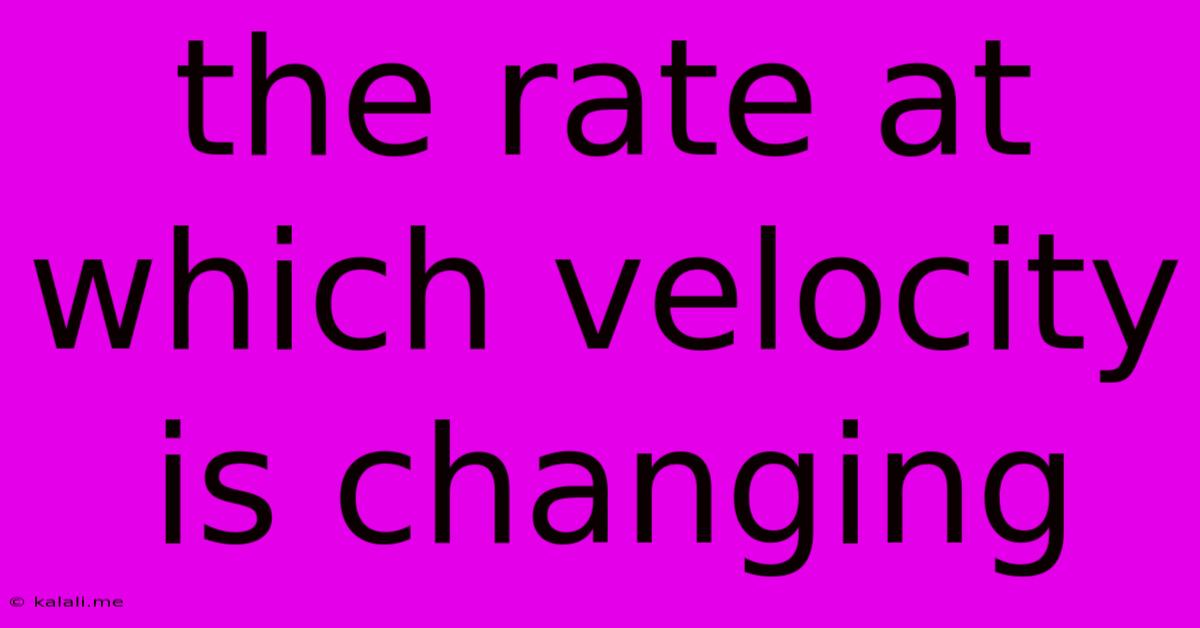The Rate At Which Velocity Is Changing
Kalali
May 09, 2025 · 3 min read

Table of Contents
The Rate at Which Velocity is Changing: Understanding Acceleration
The rate at which velocity is changing is known as acceleration. This is a fundamental concept in physics, crucial for understanding motion and forces. While often simplified to a change in speed, acceleration is more accurately defined as the rate of change of both speed and direction. This article will delve into the nuances of acceleration, exploring its calculation, different types, and practical applications.
Understanding acceleration is vital for analyzing projectile motion, designing efficient vehicles, and predicting the behavior of objects under various forces. Let's break down this key concept in detail.
Defining Acceleration: More Than Just Speeding Up
Many people associate acceleration solely with increasing speed. While an increase in speed is a form of acceleration, it's not the complete picture. Acceleration is a vector quantity, meaning it has both magnitude (size) and direction. This means that a change in direction, even at a constant speed, constitutes acceleration.
Consider a car driving around a circular track at a constant speed. Even though the speed remains the same, the car is constantly changing direction, resulting in a centripetal acceleration towards the center of the circle.
Calculating Acceleration
The calculation of acceleration is relatively straightforward. It's determined by the change in velocity divided by the time it takes for that change to occur. The formula is expressed as:
a = (v_f - v_i) / t
Where:
- a represents acceleration
- v_f represents final velocity
- v_i represents initial velocity
- t represents time
This formula assumes constant acceleration. If acceleration is not constant, more complex calculus methods are needed.
Types of Acceleration
There are several ways to categorize acceleration:
- Positive Acceleration: Occurs when an object's velocity increases in the direction of motion. Think of a car accelerating from a standstill.
- Negative Acceleration (Deceleration): Occurs when an object's velocity decreases. This happens when a car brakes or an object slows down due to friction.
- Zero Acceleration: Occurs when an object's velocity remains constant, both in magnitude and direction. An object moving at a steady speed in a straight line has zero acceleration.
- Centripetal Acceleration: As mentioned earlier, this type of acceleration occurs when an object moves in a circular path at a constant speed. The acceleration is directed towards the center of the circle.
- Tangential Acceleration: This type of acceleration is present when an object's speed changes while moving along a curved path. It acts along the tangent to the curve.
Applications of Understanding Acceleration
Understanding acceleration is essential in numerous fields:
- Engineering: Designing safe and efficient vehicles, predicting the performance of machines, and analyzing structural integrity under dynamic loads.
- Physics: Modeling projectile motion, understanding orbital mechanics, and studying the behavior of particles in various fields.
- Sports Science: Analyzing athletes' performance, optimizing training techniques, and improving athletic equipment.
Conclusion: A Key Concept in Motion
The rate at which velocity is changing – acceleration – is a fundamental concept with far-reaching implications. Whether it's a simple change in speed or a complex change in direction, understanding acceleration is crucial for interpreting and predicting motion in various contexts. This comprehensive understanding allows for advancements in numerous fields, highlighting its importance in both theoretical and practical applications.
Latest Posts
Latest Posts
-
Words That Start With Y In Science
Jul 12, 2025
-
Prevent An Expressway Emergency By Merging Without
Jul 12, 2025
-
How Many Grams Of Sugar In A Pound
Jul 12, 2025
-
7am To 11am Is How Many Hours
Jul 12, 2025
-
If Your 35 What Year Was You Born
Jul 12, 2025
Related Post
Thank you for visiting our website which covers about The Rate At Which Velocity Is Changing . We hope the information provided has been useful to you. Feel free to contact us if you have any questions or need further assistance. See you next time and don't miss to bookmark.